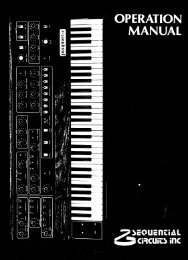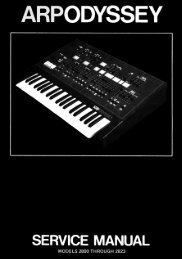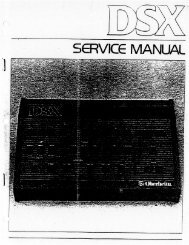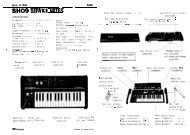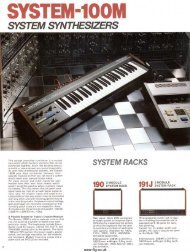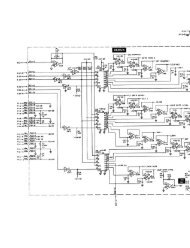ARP2600 - Fundamentals of Music Technology - Cyborgstudio.com
ARP2600 - Fundamentals of Music Technology - Cyborgstudio.com
ARP2600 - Fundamentals of Music Technology - Cyborgstudio.com
You also want an ePaper? Increase the reach of your titles
YUMPU automatically turns print PDFs into web optimized ePapers that Google loves.
SECTION5NOISE GENERATORA NOISY PARTNERSo far, three different sound producing modules have been explored.VCO-1, VCO-2, and VCO-3 all had several things in <strong>com</strong>mon. Eachcould produce a variety <strong>of</strong> timbres by producing different waveformsand each could be frequency modulated from an external source. Thenoise generator is very different from all <strong>of</strong> these modules, but is stilla highly useful tool.The most obvious thing one can see when first looking at the noisegenerator is what it lacks. It has only an output, and no inputs whatsoever.Because it has no inputs, it is impossible to modulate any parameters<strong>of</strong> the noise generator. It does have one output, which can bepatched to the mixer so that it may be heard. Unfortunately, this is not<strong>of</strong> much use, as sustained noise is only slightly less interesting to listento than the raw output <strong>of</strong> an oscillator. CD track 18Figure 5-1: The Noise GeneratorTHE NOISE GENERATOR’S PARAMETERSIt is clear just by looking at Figure 5-1 that the noise generator has two different parameters: The firstparameter is level or amplitude. The noise generator has a dedicated slider (the right one) to determineits output volume. (Level, volume, and amplitude all mean the same thing.)The second parameter is the noise generator’s harmonic content. Understanding this parameter requiressome understanding <strong>of</strong> what the noise generator does. The noise generator produces noise. Thismuch is obvious, but what is noise really? Noise can be defined as any unpitched sound. That is, alistener cannot hear any single pitch or tone when listening to the sound since it has so many frequenciespresent in such high amounts. The waves studied so far have had a very organized series <strong>of</strong> harmonics,and the harmonics were all present in relatively small amounts. In noise, there are millions <strong>of</strong>harmonics, all at a relatively high level. One example <strong>of</strong> noise is the static sound a television makeswhen it is unplugged from the antenna or cable.WHAT COLOR IS THAT NOISE?Not all noise is the same however, and electronic musicians describe the frequency content <strong>of</strong> noiseusing colors. White noise is a random amount <strong>of</strong> all frequencies simultaneously. Humans tend to hearsome frequencies better than others, specifically those most used in human speech. White noise, whichhas all frequencies will tend to sound like it is predominantly 1-2 kHz, because that is the range humanshear best. It is important to think <strong>of</strong> the noise generator and white noise as a random source. There willbe times in the future when a random source is needed to carry out other tasks, and this is an area wherethe noise generator is perfect.036




